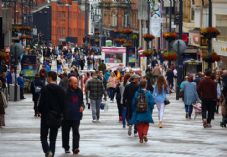UK DIY News
Retail Chain Store Closures Exceeded 17,500 In 2020

Data from PwC and the Local Data Company reveals that chain stores (retailers with five or more outlets) closed at a rapid rate in 2020.
The Retail Briefing 2021 report revealed a record net decline (-9,877), number of closures (17,532), and a new low in the number of store openings (7,655). That’s equivalent to an average of 48 chain stores closing every day, and only 21 openings, even before the true impact of the pandemic is felt.
Many of the CVAs and administrations in the early part of 2021 haven’t been captured in this report, including department stores, fashion retailers and hospitality operators that will leave big holes in city centre locations.
Different regions, different fortunes
When compared with previous years’ data, PwC says that there is greater regional disparity and a reversal of the trends we’ve come to expect. The figures show that London, South East and the North West have seen the most closures, as they have more chain stores than other parts of the country. Wales, Scotland and the North East have had the fewest closures, but historically fewer retail centres and fewer chain stores.
The City Exodus - people shopping local
The report highlights the impact of consumer behaviours on retail locations; for example, the shift towards working from home is driving how retail locations have been most affected by closures. It noted that city centres are now faring worse than suburbs and commuter towns, and shopping centre shops are twice as likely to close as retail parks.
Large city centres - such as Birmingham, Bristol, Leeds and Newcastle - have been heavily impacted by the change of working behaviours. With fewer people visiting city centres, these areas have seen an almost 8% decline in multiple stores. While London does fare slightly better on this measure (-7%), its performance is inflated because of the inclusion of its prosperous suburbs.
Suburbs across the UK have done better, as have commuter towns in North, South, East and West of the Capital, such as Welwyn Garden City, Orpington, Harlow and Slough. There have also been fewer closures in the smallest towns and seaside towns around the country, such as Scarborough, Eastbourne, Great Yarmouth and Llandudno.
Different locations, different fortunes: Retail parks seeing the most success
For the first time, the report notes that we’re seeing a widening gap between different types of locations: high-street and shopping centres are faltering, but certain retail parks are prospering.
The drop off in high-street footfall has affected those multiple retailers located on high streets, particularly those in populous areas. However, this decline in multiples has been somewhat offset by growth in interest of local and independent operators. Gathering momentum since PwC and LDC first identified the trend in May 2020, a prolonged lockdown has led consumers to rediscover local high streets. Many are now keen to support these local and independent retailers that have helped them through these times.
Elsewhere, shopping centres have fared worst of all. Not only are they often poorly located for this new type of consumer behaviour we’re seeing (i.e. increased local shopping, decreased city centre travel), but they’re also affected by the resident operators, such as comparison retail that can easily be done online (e.g. fashion) or chain hospitality operators that have overexpanded into difficulty.
However, it’s good news for retail parks. Footfall has held up, they are in demand and have seen the smallest number of net closures of any location. For some, it’s because they are anchored by essential retailers that have remained open, even during the tightest restrictions. But it’s also because they’re considered safer in the current environment: free parking means it’s possible to drive to the location (and avoid public transport), outdoor areas mean reduced indoor mixing and larger units allow for better social distancing measures.
This is not a uniform trend across all retail parks, though. Those anchored by essential retailers and categories that can’t move online - such as grocery or discount - have been more resilient than others. Those anchored by fashion or leisure, for example, have fared significantly worse.
Source : PwC and Local Data Company data
Image : Baloncici - istock.com 1051698118
Insight DIY always publishes the latest news stories before anyone else and we find it to be an invaluable source of customer and market information.











































